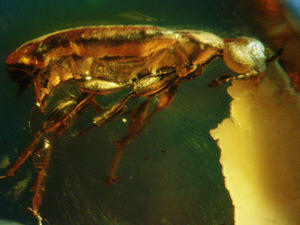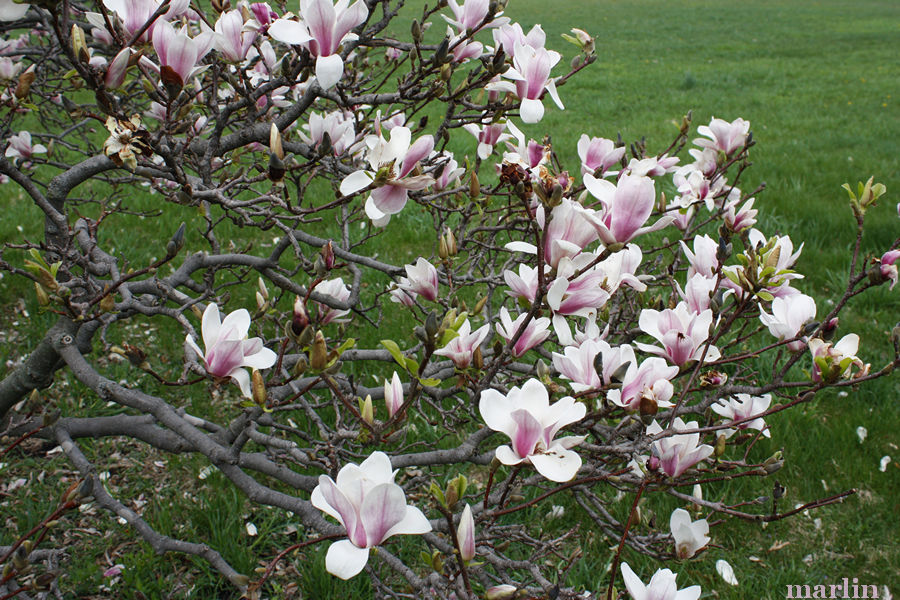Lilliputian Saucer Magnolia – Magnolia x soulangiana ‘Lilliputian’

Lilliputian Saucer magnolia is a smaller, more compact version of the familiar saucer. It makes an outstanding specimen tree in a sunny spot where it can develop a symmetrical crown. Its large (5 to 8 inch) fragrant white-with-pink underside flowers create an amazing floral display. However, early-spring blooming plants like this cultivar are more and more being fooled into blooming too early by our increasingly warm springtimes – and any frost will ruin the flowers for that season [6].
Saucer Magnolia grows best in rich, moist but well-drained soil. Will tolerate some shade, but growth may be sparse and the flowers less profuse. Saucer Magnolia dislikes dry or alkaline soil but will otherwise does well in an urban environment (although salt aerosols are to be avoided). Transplant in the spring, just before growth begins, or buy balled and burlapped or containerized plants. Older plants do not like to be pruned and large wounds may not close well [6].
Lilliputian Saucer Magnolia is 47 years old
 |
The genus Magnolia contains about 200 species of flowering trees and shrubs, with innumerable cultivars and varieties being developed all the time. Magnolia is an ancient plant lineage, first appearing in the fossil record about 20 million years ago, while evidence of plants in the family goes back to 90 mya [5]. Having evolved before pollinators in Hymenoptera (bees, wasps & ants) appeared, the progenitors of our modern ornamental magnolias relied on beetles for their sexual gratification. Their large, showy flowers are a direct result of the plant’s strengthening its delicate flower parts against the beetle’s comparitively “rough handling” while feeding on pollen. Left: Primitive beetle ancestor inside 50 million year old Baltic amber [4]. |

The earliest flowering plants date back about 130 million years. According to Cronquist Evolution and Classification of Flowering Plants, the most primitive of all living angiosperms belong to the subclass Magnoliidae. This subclass contains several primitive plant families, including the water-lily family (Nymphaeaceae), buttercup family (Ranunculaceae) and Magnoliaceae. Plants in the magnolia family have the following characteristics:
- Large flowers with numerous tepals
- Numerous spirally arranged stamens at the base of a conelike receptacle bearing numerous spirally arranged carpels. At maturity the carpels develop into a woody, conelike aggregate of seed-bearing follicles. Each seed has a fleshy red outer layer (aril) and hangs from its follicle by a threadlike stalk. Other primitive floral characteristics are radial symmetry or actinomorphic (floral parts similar in size & shape), perfect (with functional androecium and gynoecium), complete (with all 4 floral parts: calyx, corolla, androecium & gynoecium), and floral axis (receptacle) elongated. The latter characteristic is clearly visible in the magnolia blossom. With all the woody, spirally arranged carpels (follicles), this axis truly resembles a conelike structure [2].
Taxonomic relations in the family Magnoliaceae have been puzzling botanists for a long time. Because the family is quite old and has survived many geological events such as ice ages, mountain formation and continental drift, the family’s distribution is scattered nearly worldwide. Some species have been isolated for a long time, while others were in close contact and able to exchange gentic material until later in their lineage. To create divisions in the family solely based on morphological characteristics has proven to be an impossible task.
References
- Colin Tudge, The Tree: A Natural History of What Trees Are, How They Live, and Why They Matter
- National Audubon Society, Field Guide to North American Trees
- Saucer Magnolia, Morton Arboretum acc. 329-63*1, photos by Bruce Marlin
- Anders L. Damgaard, File:Baltic amber Coleoptera Scraptiidae.JPG under Creative Commons 3.0
- Wikipedia contributors, “Magnolia” retrieved April 19, 2012
- Edward F. Gilman, University of FLA, ENH-548 “Lilliputian Magnolia” Retrieved April 19, 2012. Excerpts used with permission.
Family Rosaceae – Rose Family; Fruit Trees
Trees Index | Pine Family | Beech, Oak | Nut Trees | Birch Family | Magnolias
Tree Encyclopedia / North American Insects & Spiders is dedicated to providing family-friendly educational
resources for our friends around the world through large images and macro photographs of flora and fauna.

